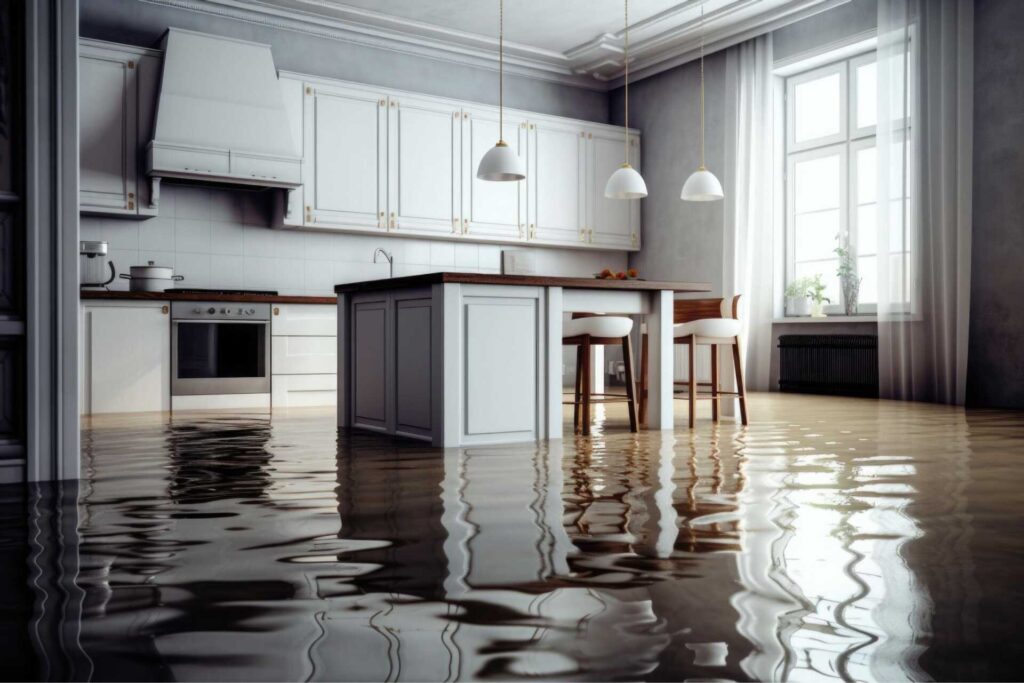
Contents
Many people underestimate the complexity of flood recovery, often thinking it’s just about removing water. In reality, effective recovery involves a series of critical steps that require both skill and strategy. From selecting the right tools to ensuring safety measures are in place, every decision impacts the outcome. Understanding these nuances can make all the difference when facing such an intimidating challenge. What should you prioritize first to ensure a successful recovery?
Key Takeaways
- Utilize submersible pumps for deep water removal and wet/dry vacuums for residual extraction to enhance efficiency.
- Ensure protective gear is worn during water removal to minimize health risks from contaminants.
- Turn off all utilities, including electricity and gas, to prevent further dangers before starting recovery efforts.
- Place dehumidifiers and fans in affected areas to promote air circulation and prevent mold growth.
- Regularly monitor humidity levels, aiming for below 60%, to ensure thorough drying of the environment.
Assessing the Situation: Safety First
When you begin evaluating the situation after a flood, prioritizing safety is essential. Start with a thorough situation analysis. Look for hazards like downed power lines, unstable structures, or contaminated water. Assess the risks posed by these dangers to yourself and others. A clear understanding of your environment will help you make informed decisions.
Next, conduct a risk assessment by identifying areas that pose the highest threats. This might include flooded basements or damaged roads. Remember to take into account emotional and psychological impacts as well; floods can leave lasting scars. If you notice anyone in distress, offer support, but keep your safety in mind.
As you navigate through the aftermath, be cautious and vigilant. Document any observations for future reference, as they can be invaluable for recovery efforts.
Gathering Essential Water Removal Tools
To effectively tackle water removal after a flood, you’ll need to gather several important tools that can make the process efficient and safe.
Start with water removal equipment like submersible pumps, which can quickly expel large amounts of water, and wet/dry vacuums for smaller areas. Don’t forget about fans and dehumidifiers; they’ll help dry out the space and prevent mold growth.
Next, stock up on necessary supplies such as buckets, mops, and rags for manual clean-up. Protective gear is essential too—gloves, masks, and waterproof boots will keep you safe from contaminants.
Finally, consider having moisture meters on hand to assess the drying progress. Each tool plays a significant role in minimizing damage and ensuring your recovery strategy is effective.
Turning Off Utilities to Prevent Further Damage
Before you begin any recovery efforts, it’s vital to turn off utilities like electricity, gas, and water to prevent further damage and secure your safety.
Starting with electricity, locate your main breaker and switch it off to avoid electrical shocks or fires. Next, follow proper utility shutoff procedures for gas; this usually involves turning the valve at the meter. If you smell gas, evacuate immediately and call a professional.
For water, turn off the main supply valve to stop additional flooding from broken pipes.
Implementing these damage prevention tactics is important during a flood. Not only does it protect your property, but it also safeguards your well-being.
Removing Standing Water Efficiently
With utilities safely turned off, the focus shifts to removing standing water efficiently to minimize damage and expedite recovery.
Employing effective water extraction techniques is essential during this phase. Here are some efficient drainage solutions you can consider:
Submersible Pumps: These are ideal for deep water removal and can handle large volumes quickly.
Wet/Dry Vacuums: Perfect for smaller areas, they can effectively remove residual water.
Sump Pumps: If you have a sump pit, these pumps can continuously drain water as it accumulates.
Natural Drainage: Utilize gravity by directing water towards lower areas or existing drains, ensuring it flows away from your property.
Drying Out Affected Areas Thoroughly
As you tackle the aftermath of flooding, ensuring that affected areas dry out thoroughly is vital to preventing mold growth and further damage.
Start by utilizing effective dehumidification techniques. Place dehumidifiers in the most affected spaces to extract moisture from the air. Monitor humidity levels regularly to verify they drop to safe levels, ideally below 60%.
Next, enhance air circulation. Open windows and doors to promote cross-ventilation, allowing fresh air to flow in while stale, damp air exits. Use fans to direct airflow across wet surfaces, speeding up the drying process.
It’s essential to address hidden moisture as well. Check behind walls, under carpets, and in crawl spaces, as these areas can harbor lingering dampness.
Cleaning and Sanitizing Contaminated Surfaces
Once you’ve confirmed that affected areas are thoroughly dried, the next critical step involves cleaning and sanitizing contaminated surfaces.
It’s crucial to choose the right sanitizing techniques based on the surface materials you’re dealing with. Different materials require tailored approaches to ensure effective disinfection.
Here’s a quick guide to help you:
- Non-porous surfaces (e.g., tiles, glass): Use a bleach solution or commercial disinfectant.
- Porous surfaces (e.g., carpets, upholstery): Steam clean and apply appropriate antimicrobial treatments.
- Wood surfaces: Wipe with a mild detergent solution and make sure they dry completely to avoid warping.
- Metal surfaces: Clean with a vinegar solution to avoid rust while disinfecting.
Preventing Mold Growth After Water Removal
While you’ve successfully removed the water, the battle against mold growth has just begun, and taking immediate action is essential.
Mold thrives in damp environments, so implementing effective mold prevention strategies is vital. Start by ensuring thorough drying of all affected areas—use fans and dehumidifiers to lower humidity levels quickly.
Next, regularly monitor indoor humidity, keeping it below 60% to deter mold growth. Consider using moisture-absorbing products in areas prone to dampness, like basements.
Seal any cracks or openings in your home’s structure to minimize moisture intrusion and airflow.
Additionally, clean any surfaces that may have absorbed water, paying close attention to porous materials. If you notice any signs of mold, address them immediately with appropriate treatments.
Documenting Damage for Insurance Claims
Documenting damage for insurance claims is a critical step in your recovery process, and getting it right can greatly impact the outcome.
Thorough insurance documentation helps in the claim process and ensures you the compensation you deserve.
Here are the key elements to focus on:
Photographs: Take clear, detailed photos of all affected areas and items.
Inventory: Create a list of damaged possessions, including descriptions and approximate values.
Receipts and Records: Gather any receipts or records that can support your claim, such as purchase history for major items.
Damage Reports: If possible, obtain professional assessments to validate the extent of the damage.
Knowing When to Call in Professionals
When evaluating flood damage, it’s essential to recognize the severity of the situation and any potential health and safety risks.
If the damage appears extensive or if mold and contaminants are present, calling in professionals can be a lifesaver.
Your well-being and the integrity of your home depend on making informed decisions during this challenging time.
Severity of Damage
Determining the severity of damage after a flood can be overwhelming, especially when the extent of destruction isn’t immediately clear.
To navigate this, a thorough damage assessment is essential. Understanding flood categorization helps you identify the potential risks and necessary responses.
Here’s what to take into account before deciding to call in professionals:
- Water source: Identify if it’s clean, grey, or black water.
- Structural damage: Check for cracks or instability in walls and foundations.
- Contents: Assess whether personal belongings are salvageable or beyond repair.
- Extent of moisture: Use tools to measure moisture levels in walls and floors.
If any of these factors indicate significant damage, it’s wise to seek professional help for effective recovery.
Health and Safety Risks
After evaluating the severity of damage from a flood, it’s important to recognize the health and safety risks that can arise in the aftermath.
Standing water can harbor waterborne pathogens, which pose serious health threats if inhaled or ingested. Mold can develop quickly in damp environments, exacerbating respiratory issues and allergies.
Additionally, floodwaters often carry chemical contamination from nearby structures or industries, increasing the risk of exposure to harmful substances.
If you feel overwhelmed or uncertain about handling these dangers, it’s essential to call in professionals. They’ve the expertise and equipment to safely remove water, mitigate health risks, and ensure your environment is safe for reoccupation.
Don’t take unnecessary chances when your health is at stake.
Review
Mastering flood recovery isn’t just about removing water; it’s about ensuring a safe and thorough restoration of your space. By equipping yourself with the right tools and knowledge, you can greatly mitigate damage and health risks. Have you considered how quickly you could act in an emergency? Remember, each step you take protects your property and preserves your peace of mind. Stay prepared, stay informed, and don’t hesitate to seek professional help when needed.
Recent Posts
Why Is Emergency Water Removal Crucial After Flooding?
When flooding occurs, emergency water removal is vital to mitigate serious health risks and property
Quick Tips for Post-Flood Water Removal
After a flood, knowing how to act quickly can make a big difference. You need
10 Best Tips for Emergency Water Removal After Flooding
You might think that dealing with flooding is overwhelming, but taking swift action can greatly
